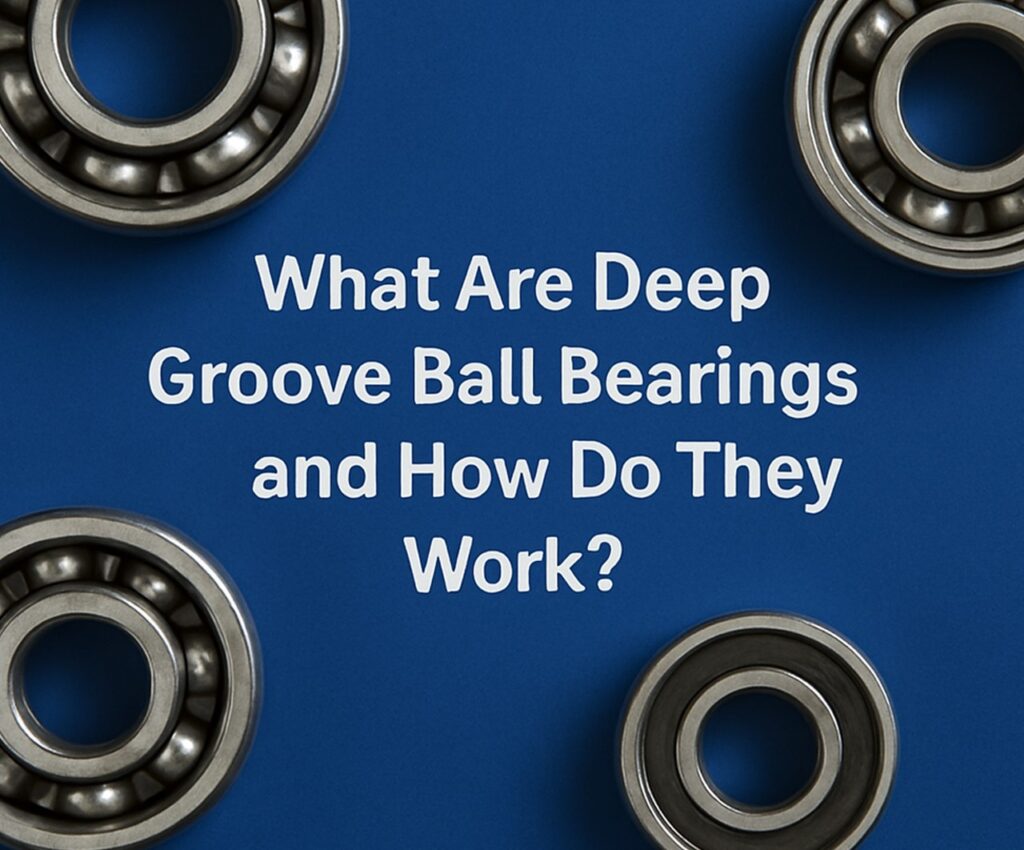Deep groove ball bearings, also known as bearing ball deep groove types, are the most common and widely used bearings across industries. Whether you’re dealing with electric motors, household appliances, or automotive systems, deep groove bearing solutions are foundational. Their popularity comes from their simple design, efficient function, and ability to support both radial and axial loads. In this article, we’ll explore how they work, where they’re used, and why they continue to be a go-to solution for engineers and manufacturers. Know More
What Are Deep Groove Ball Bearings?
At their core, deep groove ball bearings are a type of rolling-element bearing. They consist of an inner ring, outer ring, cage, and balls. The term “deep groove” refers to the deeper raceway grooves in both rings, which allow the balls to rotate smoothly. This structure enables them to handle higher speeds and a combination of loads.
What sets bearing ball deep groove models apart from other bearings is their versatility. They can operate at high speeds with low noise and friction. Their construction allows them to be used in various orientations, making them suitable for countless mechanical systems.
How Do Deep Groove Ball Bearings Work?
Deep groove bearing systems reduce friction between rotating parts by using hardened steel balls contained within deep grooves. As the shaft turns, the balls roll between the inner and outer races, minimizing contact and reducing heat. This smooth rolling motion is what makes them so efficient.
The geometry of the raceways and the close conformity between the balls and raceways enable these bearings to support both radial loads (forces perpendicular to the shaft) and axial loads (forces parallel to the shaft). This dual-load capacity is one reason deep groove ball bearings are preferred in many applications.
Advantages of Deep Groove Ball Bearings
- Simplicity: Their straightforward design makes them easy to install and replace.
- Cost-effective: Mass production and minimal maintenance lead to low costs.
- Versatility: Suitable for high-speed, low-friction environments.
- Load capacity: Can support both radial and axial loads.
- Quiet operation: Ideal for appliances and systems where noise is a concern.
Because of these features, bearing ball deep groove solutions are the first choice in high-performance and cost-sensitive environments.
Where Are Deep Groove Ball Bearings Used?
Deep groove bearing systems are everywhere. Here are just a few examples:
- Electric motors: From industrial machinery to fans and HVAC systems.
- Automobiles: Used in transmissions, wheels, and alternators.
- Household appliances: Washing machines, refrigerators, and dishwashers.
- Medical devices: Precision equipment and lab tools.
- Aerospace: Lightweight, high-speed applications.
Their wide range of sizes and types allows deep groove ball bearings to be customized to meet specific industry needs.
Types of Deep Groove Ball Bearings
There are several variations of bearing ball deep groove designs:
- Single-row deep groove ball bearings: Most common type, designed for high-speed operation and moderate load handling.
- Double-row deep groove ball bearings: Higher load capacity, ideal when space is limited and heavier loads are expected.
- Sealed or shielded bearings: Protect against contamination and retain lubrication.
- Miniature deep groove ball bearings: For compact and precise applications like robotics or medical devices.
Each type offers different benefits, but all share the foundational efficiency of deep groove bearing technology.
Materials and Innovation
Most deep groove ball bearings are made from chrome steel or stainless steel, offering durability and resistance to corrosion. However, newer materials such as ceramics and hybrids (ceramic balls with steel races) are becoming more common.
Ceramic bearing ball deep groove options offer lower weight and higher speed capabilities. They also resist heat and wear better, making them ideal for demanding environments. The innovation in materials allows deep groove bearing technology to evolve with modern machinery and industry needs.
Maintenance and Lifespan
One reason deep groove ball bearings are so widely used is that they require minimal maintenance. Proper lubrication is key. Many models come pre-lubricated with grease, and sealed options prevent dirt and moisture from entering.
Still, even the most robust bearing ball deep groove models need occasional checks. Misalignment, overloading, and improper installation can reduce lifespan. With proper care, though, these bearings can last for years in continuous operation.
Choosing the Right Bearing
When selecting a deep groove bearing, consider:
- Load requirements: Know your radial and axial load needs.
- Speed: Higher speeds may require specific materials or lubrication.
- Environment: Dusty, wet, or corrosive settings may call for sealed or stainless steel options.
- Size constraints: Measure shaft diameter and available space accurately.
Manufacturers offer catalogs and software tools to match the best deep groove ball bearings to your specific needs.
Trends and Future Outlook
With the rise of automation, robotics, and electric mobility, the demand for reliable and compact bearing ball deep groove components is growing. Industry trends are pushing for quieter, faster, and longer-lasting deep groove bearing designs.
Smart bearings with built-in sensors are also on the horizon. These could monitor load, temperature, and vibration in real-time, improving performance and preventing breakdowns. As machinery becomes more intelligent, so will the components inside.
Conclusion
Deep groove ball bearings may look simple, but they are powerful, high-precision components that keep our machines running smoothly. With their ability to handle combined loads, operate quietly, and resist wear, it’s no surprise that bearing ball deep groove systems dominate so many industries.
Whether you’re an engineer building the next generation of electric vehicles or a manufacturer maintaining assembly lines, deep groove bearing solutions will continue to be a reliable cornerstone of mechanical design.
So next time you hear the hum of a motor or feel the quiet glide of a machine part, there’s a good chance that deep groove ball bearings are hard at work behind the scenes.

